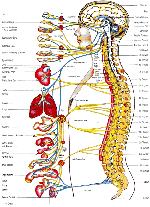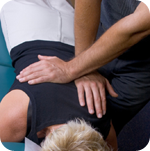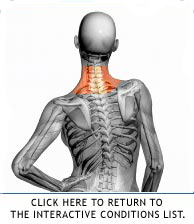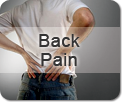


Conditions Treated
Degenerative Arthritis
Arthritis is a commonly misused term and an overly simplified approach to an appropriate diagnosis. Most people, from their mid 20s through their late 70s and beyond,
have some type of degenerative arthritic changes in the neck. The neck has numerous joints that can easily become damaged and inflamed from daily repetitive microtraumas
(the same activities day in and day out). Once the inflammation reduces, scar tissue forms and restricts normal motion to the neck, causing "clicking", "popping", and even
"grinding" sounds. Over time the scar tissue thickens and less blood supply and nutrition are able to feed the spine. As a result, the bones and discs begin to waste away,
and eventually the scar tissue calcifies, thus producing spurs which over time
 fuse the neck vertebrae together, causing great stiffness.
fuse the neck vertebrae together, causing great stiffness.
Treatment Plan
The doctors will stop the process of degeneration by using specific non-forceful joint manipulations to restore function and motion to various spinal areas. The treatment may include heat, massage, and other physical therapy modalities to assist in this process. We will provide exercises for strength and flexibility to assist in blood and nutrient flow.
About Neck Pain
It is estimated that nearly every American will experience some type of Neck Pain in his/her lifetime. Ironically, unlike Lower Back pain, most people do not actively seek treatment until the pain is too intense. Instead they self-medicate with over the counter drugs or experiment with prescription drugs. Most neck problems are Neuro-musculo-skeletal, meaning the root of the problem is from a nerve, a muscle, a bone or all three. Click below for a brief analysis of various conditions treated successfully in our office. Herniated Disc A disc does not "slip". It can tear, bulge, or herniate. All are problems which affect exiting nerves from the spine that irritate muscles via intermittent spasm. This condition can cause numbness, burning pain, and tingling into the shoulder blade or into the arm and fingers. People often have difficulty turning their head, as well as finding a comfortable position for their neck when sleeping.
Less than 1% of our patients require surgery as an outcome. Our plan is to use traction, electric stimulation, ultrasound and other pain controlling modalities, with a combination of special neuro-muscular pressure points to release scar tissue, and specific joint mobilization techniques that take the pressure off other spinal discs and nerve roots, so your injury can heal more quickly. We assist you with specific exercises designed for your posture, as well as exercises for home.














